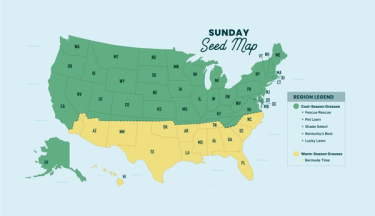When to apply new grass seed
Timing depends on what type of seed you are applying—cool-season or warm-season grass—because they are adapted to grow at different temperatures.
Cool-season grass seed
Cool-season grasses can be seeded in the spring or fall when daily average temperatures consistently hover between 55 and 75 Fahrenheit.
Warm-season grass seed
If grass can be seeded (like Bermudagrass), warm-season grasses can be seeded when daily average temperatures are between 70 and 90 degrees Fahrenheit.

Sunday Tip:
If you seed warm-season or cool-season grasses before optimal growing temperatures, the seeding will likely not be successful.
How to seed a new lawn: step-by-step guide
Depending on where you live, spring or fall is the best time for growing new grass. Let's get started.
1. Select the right grass seed
What's the best grass seed for new lawns? Our new Seed Finder Tool can help you choose a grass type well suited to your soil, climate, and the level of work you want to do.
Remember, each grass variety has its strengths and weaknesses, and putting some thought into it now will save you trouble down the road.
2. Prep your soil
You can do this for most lawns by gently raking through the seeding area. A metal rake gets through the soil's surface to improve seed-to-soil contact.
Helpful tips for more challenging soils
- Rototilling can be helpful for clay-heavy and easily compacted soil.
- Got an uneven lawn? Now is the perfect time to level it out!
3. Determine the right seeding rate
Apply grass seed according to the recommended rate on your grass seed's product label, or use our updated seeding rate guide below!
For seeding new lawns, we recommend seeding at these rates*:
- Fescue Rescue: 8 lbs. per 1000 sq. ft.
- Shade Select: 5 lbs. per 1000 sq. ft.
- Lucky Lawn: 5 lbs. per 1000 sq. ft.
- Pet Lawn: 8 lbs. per 1000 sq. ft.
- Kentucky’s Best 2 lbs. per 1000 sq. ft.
- Bermuda Time: 1 lb. per 1000 sq. ft.
*For size reference: 1000 sq. ft. is about the size of a volleyball court!
Detailed guidance on Sunday's grass seed instructions
4. Sow your seeds
Use a seed spreader to spread the seeds across your lawn. After the seed has been disbursed, gently rake the area so most of the seed is beneath the soil. You can also cover the area with a thin layer of straw or compost—this will help with water retention and boost organic matter in the soil.
5. Water wisely
Watering is vital to get your grass growing. On the day you sow, water until the soil is saturated. After that, ensure your soil is moist daily, but don’t over-water. How much and how often you need water to keep your soil moist depends on your climate and soil type.
Sunday Tip:
If the soil surface is dry, is more water necessary? Maybe. There may be enough moisture beneath the surface for the grass. To check, get a bamboo chopstick and stick it 3 inches deep in the soil and leave it there for about 10 minutes. Pull it out and moisture levels will be easy to see.
6. Stay off the lawn
After the seeds have been sown, keep the area traffic-free until grass sprouts and the blades thicken. There’s a lot of important stuff under the soil that you don’t want to disturb! Even after grass sprouts, it’s still pretty vulnerable until it thickens and your first mow.
When will new grass sprout
The next step is setting your expectations for growth rate. Different grass species have different germination times, which can range from a week to a month. Below are common germination rates.
- Fescues: 6-12 days
- Perennial rye: 3-7 days
- Kentucky bluegrass: up to 21 days
- Bermudagrass: 7–21 days
If you don’t see sprouts right away, keep up with watering, and don’t worry. These things take time.
How to water new grass
Once sprouts appear, it's official—you're growing new grass! Pat yourself on the back, then continue watering regularly to keep the soil moist, but you can start to cut back on the volume.
You’ll notice that new sprouts will continue to emerge for a few days. After most seeds have sprouted, you can start transitioning to a more normal watering schedule.
When to mow new grass
You can start mowing once the grass is thick and established. Once the blades are dense, you still want to be somewhat gentle with your lawn in its first year. This means no rugby tournaments or harsh pesticides, but regular foot traffic is fine!
When to fertilize new grass
We recommend waiting for 60 percent of the seed to actively grow (roughly three weeks after planting) before applying Sunday nutrients to your newly seeded lawn. This will allow grass to absorb the nutrients better and help your new grass grow thick and green.
Keep it growing
Ready to start? Learn more about choosing the right grass type for your lawn.
Ready to shop? Check out Sunday’s A-LIST premium grass seed mixes — the best seed available on the market.
Sunday Tip:
What's A-LIST mean? A-LIST-approved seeds are independently certified for high quality and to thrive with lower water and fertilizer applications.
Let's get growing
Our lawn engine uses satellite data to map out your lawn size and determine things like average rainfall, common weeds, and pest activity.



















